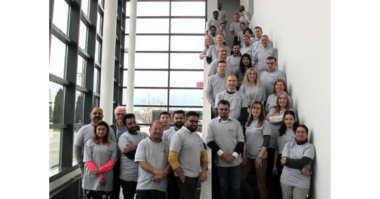In their significant new article, “The Only Way Manufacturers Can Survive,” published in the Spring 2019 issue of MIT Sloan Management Review, innovation expert Vijay Govindarajan and former CEO and chairperson of GE Jeffrey Immelt contend that executing a digital transformation is not only the most complex but also the most critical challenge that industrial companies face today.

“Most of the business leaders we talk to can sense, but don’t fully realize, just how big a threat digitalization poses for manufacturers,” they write. “Many CEOs miss the fact that a digital transformation isn’t the same as the digitalization of an existing business. It isn’t about creating websites, mobile apps, social media campaigns, and online sales channels. A digital transformation entails reimagining products and services as digitally enabled assets; generating new value from the interconnection of physical and digital assets through data; and creating ecosystems to make that possible.”
Though digital transformations are crucial for survival and require a fundamental change in business and organizational activities, processes, competencies, and business models, there are no playbooks and few best practices for manufacturers to follow when making the shift.
Immelt and Govindarajan draw on their collective decades of experience to explain why it is so tough for manufacturers to go digital, and they share their hard-earned insights on how CEOs and other senior business leaders can work through those challenges and set up their organizations for longevity.
First, they identify three major obstacles manufacturers must overcome in order to escape inertia and become digital-industrials:
- Incumbency: Leaders stick with existing business models because they work and don’t notice threats from disruptive new ones. The incentive for change is low while existing models are performing at their peak.
- Talent: Until recently, most manufacturers treated digital technology as a backroom function to support their existing businesses, choosing to outsource its development. They paid little attention to cultivating the skills to carry out a digital transformation. Moreover, manufacturers generally have a tough time attracting much-in-demand digital talent.
- Culture: Manufacturers believe in continuous improvement, digital companies in constant innovation. To become more digital, industrial organizations must embrace concepts alien to them such as agility, simplicity, responsiveness, and speed. This is often a challenge for well-established enterprises geared to deliver cost-effective products at predictable intervals.
Next, the authors identify and answer common questions that often stump leaders and stymie the transformation process, including: Wouldn’t it be quicker and less investment-intensive to outsource the creation of digital capabilities or enter into a partnership? (no); Shouldn’t we use IT people we already have rather than hiring fresh people who don’t know our businesses? (no); Shouldn’t we set up a few digital pilots and learn from those rather than going all in at once? (maybe).
Finally, Immelt and Govindarajan address strategy execution, the toughest challenge for leaders. They write: “CEOs must rethink virtually everything about how their companies work and create new business models, develop fresh organizational structures, and lead very differently.” They offer key insights into how leaders can create new value through digital transformation, restructure to allow for a smoother integration of old industrial business and new digital business, and lead with courage in the face of uncertainty.
“Digital transformation is a long-run strategy,” Immelt and Govindarajan conclude. “CEOs should never need to apologize for investing in it. If industrial companies don’t continue to invest in digital transformations, they will create markets that either industrial rivals or digital natives will seize without much fanfare. It’s crucial that they transform themselves today.”
To read the full article, please visit MIT SMR.
About the authors:
Vijay Govindarajan (@vgovindarajan) is the Coxe Distinguished Professor at Dartmouth College’s Tuck School of Business. He was the first professor in residence and chief innovation consultant at General Electric. Jeffrey R. Immelt (@jeffimmelt) was GE’s chairperson and CEO for 16 years. He is currently the chairperson of Athenahealth, a partner of the venture capital firm New Enterprise Associates, and a board member of Desktop Metal, a 3-D printing startup.
About MIT Sloan Management Review
A media company based at the MIT Sloan School of Management, MIT Sloan Management Review‘s mission is to lead the conversation among research scholars, business executives, and other thought leaders about advances in management practice, especially those shaped by technology, that are transforming how people lead and innovate. MIT Sloan Management Review captures for thoughtful managers the creativity, excitement, and opportunity generated by rapid organizational, technological, and societal change.





Comments